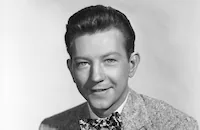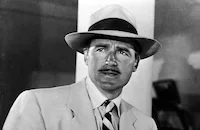This Is the Life
Brief Synopsis
Cast & Crew
Felix E. Feist
Donald O'connor
Susanna Foster
Peggy Ryan
Louise Allbritton
Patric Knowles
Film Details
Technical Specs

Synopsis
On her eighteenth birthday, Angela Rutherford receives a six thousand dollar inheritance. She tries to give it to her aunt Betsy, who has reared her since she was a child, but Betsy refuses, saying the money is now hers to do with as she wishes. Much to the chagrin of her longtime boyfriend, Jimmy Plum, Angela has fallen in love with one of Betsy's hotel guests, Major Hilary Jarret. Hilary, an Army surgeon who has been sent stateside to recover from a tropical disease, is unaware of Angela's romantic interest, as he still sees her as a little girl. While Jimmy's physician father is out of town, Hilary is forced to go on an emergency house call in his place, making him an even greater hero in Angela's eyes. Hilary, in turn, is impressed by Jimmy's handling of the situation and tries to talk the young man into attending medical school instead of joining the Army. Once he finally realizes Angela's attraction, the fully recovered Hilary rushes back to New York to resume his military medical practice. Angela and Aunt Betsy follow him there, and Hilary is persuaded to let Angela stay in his house while she continues her training as a singer. One day soon after, Hilary returns home upset, having failed his physical and been discharged from the military, and Angela uses this opportunity to propose marriage. In his weakened state, Hilary agrees to an engagement, but states that they will not discuss marriage until her first concert. Jimmy then arrives in New York for a visit, and when he learns of Angela's engagement, he refuses to stay with the "happy couple." Later, Hilary goes to the boardinghouse where Jimmy is staying, and when he is unable to convince the young man to return home with him, the surgeon purposely leaves his dog Smokey behind. Jimmy tries to return the dog, but along the way, Smokey runs away from him and into the arms of photographer Harriet West, Hilary's ex-wife. Overhearing Harriet say that she is going to the Penguin Club that night, Jimmy takes Hilary and Angela there as well, and the surgeon and the photographer are briefly reunited. Upon the advice of love-struck nightclub singer Sally McGuire, Jimmy makes numerous attempts to get Hilary and Harriet together, all with seemingly little success. It does, however, make Angela jealous, and she rushes to Harriet's apartment where, through eavesdropping, she discovers that Hilary is still in love with his ex-wife. Later, at her first concert, Angela arranges for Hilary and Harriet finally to be reunited. Jimmy, now enlisted in the Army, is then reunited with Angela during a camp show, which he has produced with the help of Sally.

Director
Felix E. Feist
Cast

Donald O'connor
Susanna Foster

Peggy Ryan

Louise Allbritton

Patric Knowles

Dorothy Peterson

Jonathan Hale

Eddie Quillan
Frank Jenks

Frank Puglia
Maurice Marsac
Virginia Brissac
Ray Eberle
Bobby Brooks Quartette
Ben Carter Choir
Otto Hoffman
Sarah Padden

Richard Nichols
Mary Thomas
Pat Dillon
Libby Taylor
Jack Chefe
Linda Reed
Joel Allen

Mantan Moreland
Sally Payne

Ralph Dunn

Walter Sande
Earl Dewey

Martha Macvicar
Anne Rooney
Jean Davis
Constance Purdy
Johnny Arthur
Brooks Benedict
Crew
Arthur Altman
Georges Bizet
Bernard B. Brown
Bernard W. Burton
Eugene Conrad
William Crago
Catherine Chisholm Cushing
Louis Da Pron
Louis Delatre
Walter Donaldson
Rudolph Friml
John P. Fulton
R. A. Gausman
John B. Goodman
Charles Gould
Lorenz Hart
William Hedgcock
Inez James
Jack Lawrence
Harold Macarthur
Sidney Miller
Hal Mohr
Eugene Oudin
Buddy Pepper
Albert Pestalozza
Charles Previn
E. R. Robinson
Richard Rodgers
Larry Russell
Milton Schwarzwald
Grace Shannon
Frank Skinner
Ray Snyder
Rudolf Thaler
Wanda Tuchock
Vera West

Film Details
Technical Specs

Articles
Peggy Ryan (1924-2004)
Born Margaret O'Rene Ryan on August 28, 1924, in Long Beach, California, Ryan began dancing professionally as a toddler in her parents' vaudeville act, the Dancing Ryans, and was discovered by George Murphy when she was 12. Murphy arranged for young Peggy to dance with him in the Universal musical Top of the Town (1937). She would go on to make a few more film appearances over the next few years - the most striking of which as a starving, homeless girl in John Ford's The Grapes of Wrath (1940) - yet for the most part, she was hardly noticeable apart from a few dance numbers.
Her luck changed when Universal cast her opposite another teenage hoofer, Donald O'Connor in What's Cookin'? (1942). From then on, they teamed in a series of innocuous musicals that were low on production values, but high on youthful pluck. Just check out some of their titles: Private Buckaroo, Give Out, Sisters!, Get Hep to Love (all 1942); Top Man, Mr. Big (both 1943); Chip Off the Old Block, This Is the Life, and Bowery to Broadway (all 1944). They may have not been high art, but jitterbuggin' kids loved it, and given the low investment Universal put into these pictures, they turned quite the profit.
Her career slowed down after the war. In 1945, she married songwriter James Cross, and didn't return to films until 1949, when she made two minor musicals that year: Shamrock Hill, There's a Girl in My Heart. She divorced Cross in 1952 and met her second husband, dancer Ray McDonald, in her final film appearance, a forgettable musical with Mickey Rooney, All Ashore (1953). Tragically, McDonald died in 1957 after a food choking incident, and the following year, Ryan moved to Honolulu after marrying her third husband, Honolulu Advertiser columnist Eddie Sherman. She kept herself busy teaching dance classes at the University of Hawaii, but in 1969, she found herself back in front of the camera as Jenny Sherman, secretary to Detective Steve McGarrett (Jack Lord) on the long-running show Hawaii Five-O,. She played the role for seven years, remaining until 1976.
Eventually, Ryan relocated with her husband to Las Vegas, where for the last few years, she was teaching tap dancing to a whole new generation of hoofers. She is survived by her son, Shawn; daughter Kerry; and five grandchildren.
by Michael T. Toole

Peggy Ryan (1924-2004)
Donald O'Connor, 1925-2003
Born Donald David Dixon O' Connor in Chicago on August 28, 1925, he was raised in an atmosphere of show business. His parents were circus trapeze artists and later vaudeville entertainers, and as soon as young Donald was old enough to walk, he was performing in a variety of dance and stunt routines all across the country. Discovered by a film scout at age 11, he made his film debut with two of his brothers in Melody for Two (1937), and was singled out for a contract by Paramount Pictures. He co-starred with Bing Crosby and Fred MacMurray in Sing, You Sinners (1938) and played juvenile roles in several films, including Huckleberry Finn in Tom Sawyer - Detective (1938) and the title character as a child in Beau Geste (1939).
As O'Connor grew into adolescence, he fared pretty well as a youthful hoofer, dancing up a storm in a string of low-budget, but engaging musicals for Universal Studios (often teamed with the equally vigorous Peggy Ryan) during World War II. Titles like What's Cookin', Get Hep to Love (both 1942), Chip Off the Old Block and Strictly in the Groove (both 1943) made for some fairly innocuous entertainment, but they went a long way in displaying O'Connor's athletic dancing and boyish charm. As an adult, O'Connor struck paydirt again when he starred opposite a talking mule (with a voice supplied by Chill Wills) in the enormously popular Francis (1949). The story about an Army private who discovers that only he can communicate with a talking army mule, proved to be a very profitable hit with kids, and Universal went on to star him in several sequels.
Yet if O'Connor had to stake his claim to cinematic greatness, it would unquestionably be his daringly acrobatic, brazenly funny turn as Cosmo Brown, Gene Kelly's sidekick in the brilliant Singin' in the Rain (1952). Although his self-choreographed routine of "Make "Em Laugh" (which includes a mind-bending series of backflips off the walls) is often singled out as the highlight, in truth, his whole performance is one of the highlights of the film. His deft comic delivery of one-liners, crazy facial expressions (just watch him lampoon the diction teacher in the glorious "Moses Supposes" bit) and exhilarating dance moves (the opening "Fit As a Fiddle" number with Kelly to name just one) throughout the film are just sheer film treats in any critic's book.
After the success of Singin' in the Rain, O'Connor proved that he had enough charisma to command his first starring vehicle, opposite Debbie Reynolds, in the cute musical I Love Melvin (1953). He also found good parts in Call Me Madam (1953), There's No Business Like Show Business (1954), and Anything Goes (1956). Unfortunately, his one attempt at a strong dramatic role, the lead in the weak biopic The Buster Keaton Story (1957) proved to be misstep, and he was panned by the critics.
By the '60s, the popularity of musicals had faded, and O'Connor spent the next several years supporting himself with many dinner theater and nightclub appearances; but just when it looked like we wouldn't see O'Connor's talent shine again on the small or big screen, he found himself in demand at the dawn of the '90s in a string of TV appearances: Murder She Wrote, Tales From the Crypt, Fraser, The Nanny; and movies: Robin Williams' toy-manufacturer father in Toys (1992), a fellow passenger in the Lemmon-Matthau comedy, Out to Sea (1997), that were as welcoming as they were heartening. Survivors include his wife, Gloria; four children, Alicia, Donna, Fred and Kevin; and four grandchildren.
by Michael T. Toole
Donald O'Connor, 1925-2003
Quotes
Trivia
Notes
The working titles of this film were Angela Is 22, Angela and Birthday. According to Hollywood Reporter news items, Universal first planned this film to star Deanna Durbin, then Diana Barrymore, before ultimately selecting Susanna Foster for the role. According to Hollywood Reporter pre-production news items, screenwriters Dwight Taylor and Irving Fineman were assigned to this project, but it has not been determined if any of their work was used in the released film.














